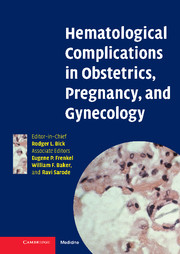Book contents
- Frontmatter
- Contents
- List of contributors
- Preface
- 1 Disseminated intravascular coagulation in obstetrics, pregnancy, and gynecology: Criteria for diagnosis and management
- 2 Recurrent miscarriage syndrome and infertility caused by blood coagulation protein/platelet defects
- 3 Von Willebrand disease and other bleeding disorders in obstetrics
- 4 Hemolytic disease of the fetus and newborn caused by ABO, Rhesus, and other blood group alloantibodies
- 5 Hereditary and acquired thrombophilia in pregnancy
- 6 Thromboprophylaxis and treatment of thrombosis in pregnancy
- 7 Diagnosis of deep vein thrombosis and pulmonary embolism in pregnancy
- 8 Hemorrhagic and thrombotic lesions of the placenta
- 9 Iron deficiency, folate, and vitamin B12 deficiency in pregnancy, obstetrics, and gynecology
- 10 Thrombosis prophylaxis and risk factors for thrombosis in gynecologic oncology
- 11 Low molecular weight heparins in pregnancy
- 12 Post partum hemorrhage: Prevention, diagnosis, and management
- 13 Hemoglobinopathies in pregnancy
- 14 Genetic counseling and prenatal diagnosis
- 15 Thrombocytopenia in pregnancy
- 16 Neonatal immune thrombocytopenias
- 17 The rational use of blood and its components in obstetrical and gynecological bleeding complications
- 18 Heparin-induced thrombocytopenia in pregnancy
- 19 Coagulation defects as a cause for menstrual disorders
- Index
- Plate section
- References
5 - Hereditary and acquired thrombophilia in pregnancy
Published online by Cambridge University Press: 01 February 2010
- Frontmatter
- Contents
- List of contributors
- Preface
- 1 Disseminated intravascular coagulation in obstetrics, pregnancy, and gynecology: Criteria for diagnosis and management
- 2 Recurrent miscarriage syndrome and infertility caused by blood coagulation protein/platelet defects
- 3 Von Willebrand disease and other bleeding disorders in obstetrics
- 4 Hemolytic disease of the fetus and newborn caused by ABO, Rhesus, and other blood group alloantibodies
- 5 Hereditary and acquired thrombophilia in pregnancy
- 6 Thromboprophylaxis and treatment of thrombosis in pregnancy
- 7 Diagnosis of deep vein thrombosis and pulmonary embolism in pregnancy
- 8 Hemorrhagic and thrombotic lesions of the placenta
- 9 Iron deficiency, folate, and vitamin B12 deficiency in pregnancy, obstetrics, and gynecology
- 10 Thrombosis prophylaxis and risk factors for thrombosis in gynecologic oncology
- 11 Low molecular weight heparins in pregnancy
- 12 Post partum hemorrhage: Prevention, diagnosis, and management
- 13 Hemoglobinopathies in pregnancy
- 14 Genetic counseling and prenatal diagnosis
- 15 Thrombocytopenia in pregnancy
- 16 Neonatal immune thrombocytopenias
- 17 The rational use of blood and its components in obstetrical and gynecological bleeding complications
- 18 Heparin-induced thrombocytopenia in pregnancy
- 19 Coagulation defects as a cause for menstrual disorders
- Index
- Plate section
- References
Summary
Introduction
Thrombophilia in pregnancy represents a challenging problem for obstetricians, reproductive medicine specialists and hematologists. Normal pregnancy is known to be associated with an enhanced risk of deep vein thrombosis (DVT) and pulmonary embolus (PE). When combined with a thrombophilic disorder, this risk is significantly enhanced, usually considered to about 5–8-fold elevated in normal pregnant women, and addition of a thrombophilia, or other clinically significant risk factor, requires particular attention to avoid unnecessary fetal loss and maternal morbidity and mortality. Thrombophilia in obstetrics and pregnancy is known to be associated with not only enhanced risks of DVT and PE, but also recurrent miscarriage syndrome, infertility, stillborn births, eclampsia intrauterine growth retardation, pre-eclampsia, frank eclampsia, HELLP syndrome and abruption, with the additional usual thrombohemorrhagic complications, such as disseminated intravascular coagulation. Indeed many women with undiagnosed thrombophilia will experience their first clinical manifestation when pregnant – usually miscarriage or DVT with or without PE. In addition, many pregnancy patients who have had a prior DVT/PE harbor an undiagnosed thrombophilic disorder, thus emphasizing the importance of adequate investigation when a suggestive personal or family history warrants. This chapter summarizes (1) antithrombotic approaches to pregnant women with thrombophilia and other risk factors, and (2) the particular thrombophilias of concern to the obstetrician, reproductive medicine specialist and hematologist. In addition, treatment discussions and recommendations will be discussed in general and then, when necessary, for any particular disorder. It must be appreciated the clinical course of thrombophilic patients, particularly during pregnancy, is highly dynamic.
- Type
- Chapter
- Information
- Publisher: Cambridge University PressPrint publication year: 2006



